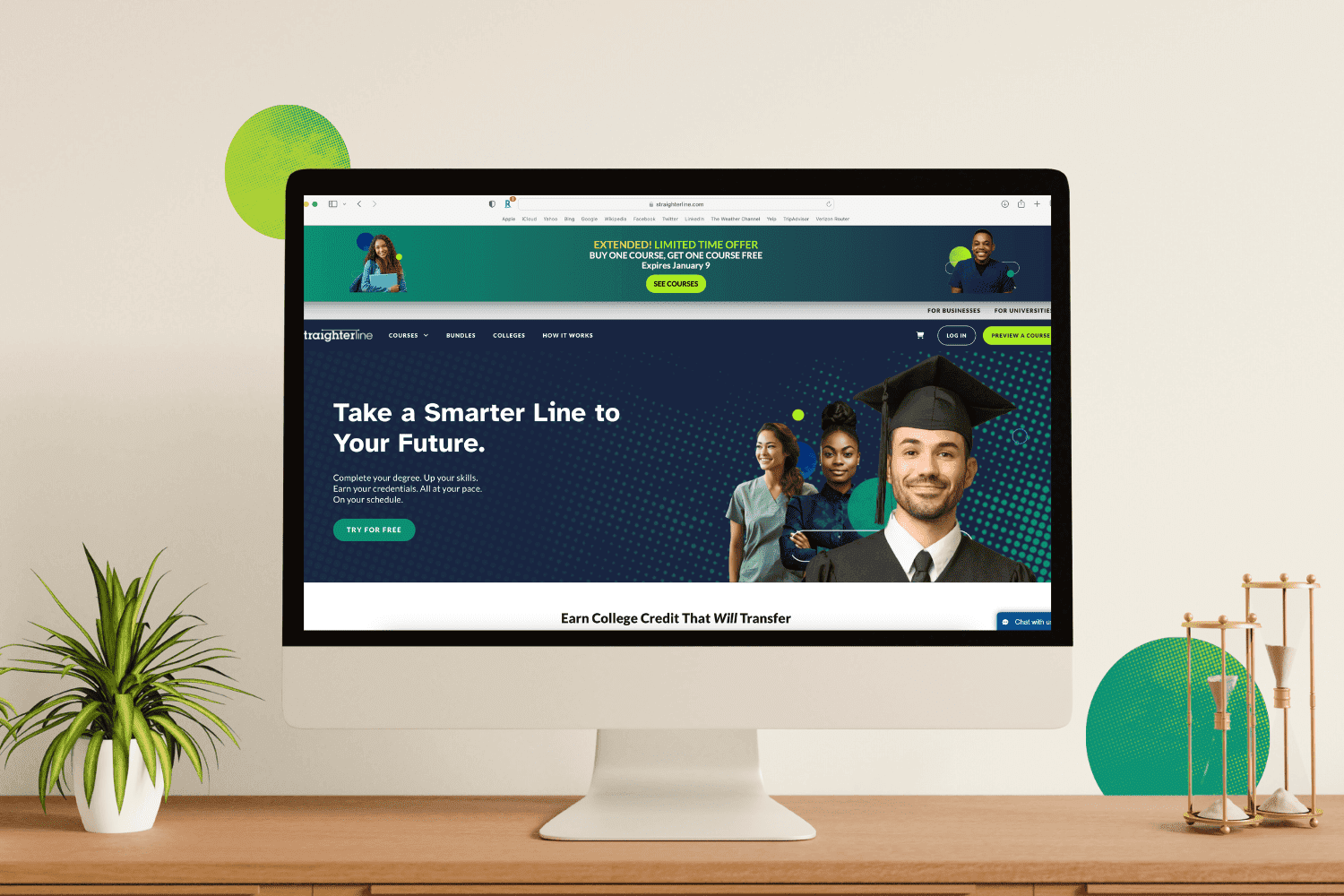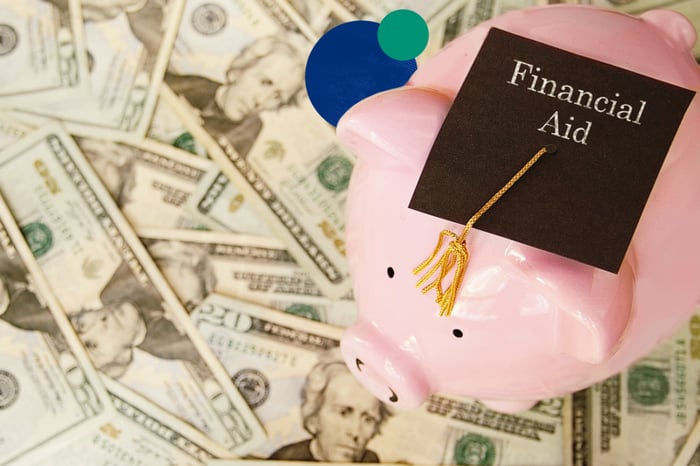There’s no doubt that the cost of college has gone up in recent years. Yet students — including adult learners — are still pursuing college degrees. Why is college so expensive? And what are some ways to cut down on the cost of earning a degree?
Learn about one of the best college credit alternatives: StraighterLine. While we don’t confer degrees, our program is designed to help all students get the transferable credits they need in an affordable, flexible way.
How Much is College Tuition?
College tuition varies based on where you go and what kind of school you attend. For example, let’s look at the average national cost (as of 2022) of a single credit hour based on a few different factors (your state or school may vary):
- Pursuing a four-year degree at a state (public) school in your state of residence: $390
- Pursuing a four-year degree at a state (public) school outside your state of residence: $1,126
- Pursuing a four-year degree at a private school, regardless of residence or location: $1,365
It’s important to note here that a credit hour is not the same thing as a full course. College courses aren’t usually held five days a week like in high school. Instead, courses are assigned a certain number of “credit hours,” which is the number of hours your school expects you to spend on your coursework per week. Typically, most college courses are worth 3 or 4 credit hours.
So, based on the number above, your average course at a public university in your state of residence would cost $1,170.
Every school has its own policies regarding the number of credit hours required to complete a degree. Most two-year (associate) degrees require around 60 credit hours, and most four-year (bachelor) degrees require 120 credit hours. The cost per credit hour, then, can really add up: at $390 per credit hour at a public school for state residents, the average price of a 4-year degree is around $47,000. And that’s just tuition.
Other Factors to Consider
Although tuition is a big part of it, there are also many other costs to consider when it comes to financing a college education:
- Miscellaneous fees: Some colleges charge additional fees that cover things like student health insurance or campus maintenance.
- On-campus housing: This refers to those students who choose to live in dorms or other school housing. On average, the cost of living in a dorm runs around $7,000 per school year. Many colleges also refer to these costs as “room and board.”
- Books and other supplies: Classes usually require textbooks or other reading materials. There may also be lab or supply costs, depending on what courses you take.
- Meals: If you live on campus, you’ll probably enroll in a dining plan. This fee covers all your meals in on-campus dining halls, cafeterias, snack bars, etc. In 2021, the average cost of an on-campus meal plan was between $1,355 and $2,145 per semester.
- Transportation: If you live off-campus as a commuter student, you’ll need to factor in the cost of things like public transportation or gas and parking.
- Personal expenses: These include anything not listed above, such as new clothes, school events, laundry, toiletries, bedding, travel, or dorm furniture.
When you add up the cost of tuition, room and board, books, and other fees, the cost of a four-year degree can run over $113,000, minimum.*
Why is College So Expensive?
It doesn’t just seem like college is more expensive than it used to be; it really is. Even adjusting for inflation, college costs have significantly shot up in the past few decades. In 1993, the average public 4-year college charged $189 (in 2022 dollars) per credit hour, or about half of what it costs today.
There are several reasons for this:
1. Higher Demand for Degrees
According to the U.S. Bureau of Labor Statistics, the more education you attain, the higher your salary. For example, someone with an associate degree earns about $160 more per week than a high school graduate with no college experience. With a bachelor's degree, that difference in salary increases to an extra $600 per week. This promise of greater professional and financial success has driven up the demand for these more advanced degrees.
2. More Student Services
College is seen as more than a place to learn. It’s considered by many to be a “life experience.” That means American schools are offering more and more student services, such as career counseling, on-campus healthcare, and state-of-the-art student centers. All those things cost money, which gets folded into the higher costs of college per year.
3. Less State Funding
Since 2008, more than half the states in the country have cut funding for their public schools. With the addition of more (and better) student services and demand for degrees, the schools necessarily transfer the cost onto students and their families.
4. Higher Salaries
As the cost of living increases, so do the salaries of college employees, including faculty and staff. Even without added student services, demand for degrees, or decreased state funding, colleges charge more simply to meet payroll needs.
How Do Most People Pay for College?
Most people pay for college through a combination of sources, including scholarships, grants, personal savings, and loans.
While loans are a popular choice for college, keep in mind that they’re not without strings attached, and they do require full repayment. So, even with a loan, you’re still paying all that money for college — plus added interest. Interest rates on loans can vary, but even a lower interest rate can add up to paying thousands of dollars more than the actual cost of your degree.
Private Loans
Private loans come from banks or credit unions. They’re typically used to bridge the gap between financial aid you may have received from your school and any costs left to pay. During the in-school and grace period, private loans offer a lower rate but switch to a higher rate when the repayment period begins. Loan rates on private loans are also usually higher than federal loan rates. Even loans with low rates might charge high fees, making this a costly option in the long term.
Federal Loans
The government issues federal loans with benefits like flexible repayment plans and loan forgiveness. They often have more lenient repayment assistance terms in case of financial hardship. Federal loans are more likely than private loans to offer a fixed interest rate so that you always know what your payments will be. However, it’s still a financial and legal obligation that requires repayment based on a contract you enter at the time of the loan.
StraighterLine vs. College Costs: a 1-to-1 Comparison
Thankfully, there are much more affordable ways to get a college education. StraighterLine is a great way to earn college credits online and save money on your degree. Let’s break down how taking courses with StraighterLine compares to paying for a traditional college education:
Affordable Tuition
StraighterLine’s courses are generally hundreds of dollars less expensive than college tuition courses, while you earn the same amount of credits. By taking courses with StraighterLine, you can save real money on tuition by eliminating the cost of the same classes at expensive schools.
Let’s take a look at a real example. Based on the figures we discussed earlier, the average cost of English Composition I — a common general education requirement for most colleges — is anywhere from $1,170 to $4,095. At StraighterLine, you can take the exact same class, also worth three credits, for just $79 plus a $99 monthly membership. If you finish the course in one month, that’s a total of $178 — even less than a single credit hour in 1993!
No Other Costs
StraighterLine’s online format helps you save on the other costs of college we discussed above. That’s because the tuition for our courses already includes your e-Textbook, and learning online means no dorm or meal plan costs, no commuting costs, and no extra college fees, either. You pay for the class you take, and that’s it!
Bundle Your Courses
Unlike traditional schools, StraighterLine offers many course bundles that save you even more money. The Core Prerequisites Bundle, for example, lets you take four of the most common core courses for just $249 (plus membership), saving you $67 from the total cost if you took each one separately.
StraighterLine vs. Traditional College: Short-Term & Long-Term Costs
The cost of college rarely comes out of your pocket. Not many people have that kind of cash sitting around. And while loans provide immediate financial support for education, the long-term costs can be substantial due to accrued interest over time.
The interest rates on student loans averaged around 5.50% for the 2023-2024 school year. Recent data indicates that the average student loan interest rate has increased in recent years by 8.02%. This means that a college education will cost even more than the upfront tuition and other fees as you repay your loan plus interest. That interest, added to the cost of tuition, adds up to thousands of extra dollars you’re paying for a college degree.
For example, if your tuition is $25,000 per year and your interest rate is 5%, you’re actually paying $26,250 for one year of tuition — or an extra $1,250 per year — when you start repaying your loan.
On the other hand, StraighterLine charges a minimal fee for the cost of membership. You pay one low out-of-pocket expense upfront and avoid hefty interest payments that can last for years or decades once you complete your degree. Combine that with our low-cost, high-quality courses, and the savings truly do add up! The more credits you earn with StraighterLine, the lower your cost at your traditional institution.
Save Money on College With StraighterLine
While StraighterLine doesn’t offer degrees, it’s an excellent platform for getting ahead in your college journey. This means completing a degree program with credits earned through our platform so you can graduate sooner and save money in the long run.
Our credits are transferable to over 170 partner colleges, so you can seamlessly transition to your school of choice. Even better, the credits you earn with StraighterLine are recognized by the American Council on Education for credit recommendations at thousands of other schools!
Check out our complete list of courses to see what you can take to get started saving money on college. And learn what our membership includes when you join StraighterLine.
*Non-tuition costs at a 4-year, in-state school: $16,532/year, $66,128 for four years. Plus $47,000 average for tuition ($390/credit hour times 120 credit hours).












